The queen wanted a quick fix to the ‘Qu’ query. You see, everyone was asking her why she never did anything without her loyal ‘U,’ and quite frankly, she quaked at the thought of being without her ‘U’!
I wonder if you’ve caught on to my quips, but if you haven’t, we are going to be exploring the ‘Qu’ spelling pattern. Additionally, we will explore two long vowel sounds that ‘U’ can make.
Make sure your student can...
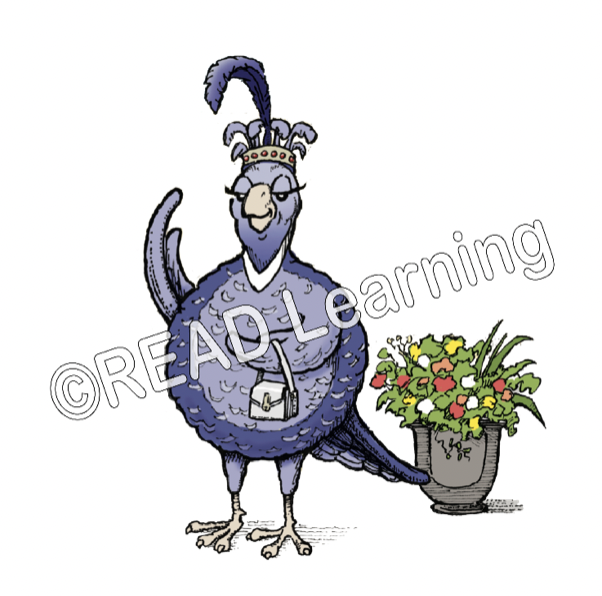
And now to introduce you to her majesty, Queen Quail. It’s important to teach your student that the letter ‘Q’ cannot stand alone without the letter ‘U.’ What’s especially fun is to recreate our story about Queen Quail and her faithful bodyguard, the letter ‘U.’ Begin by having your students visualize royalty out in public.
“Imagine the queen surrounded by her court. The letter ‘U’ is the head of her court. He is her faithful bodyguard and always comes with her wherever she goes. So whenever you’re spelling a word, always remember to add the ‘U’ after the queen. Her bodyguard will always follow after her—wherever she goes.”
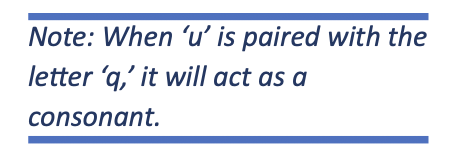
The next step is to reinforce the sound that ‘Qu’ will make. ‘Qu’ is kind of a combination sound that sounds like /kw/. When you teach this concept, practice saying the correct sound while showing a visual of the letters ‘Qu.’ Then, have your student do the same! It’s helpful to also ask your student to write the letters as they say the sound.
And that’s it! Although this seems like a simple concept, it can be tricky for students to immediately demonstrate automaticity without repetition, so get ready to find creative ways to practice. The good news is, I have some free activities at the end of this blog to help with that practice!
Now, if you look closely at our Queen Quail, you’ll notice some hidden surprises in the picture that serve as fun reminders of the rule. Speaking of, here’s the complete rule:
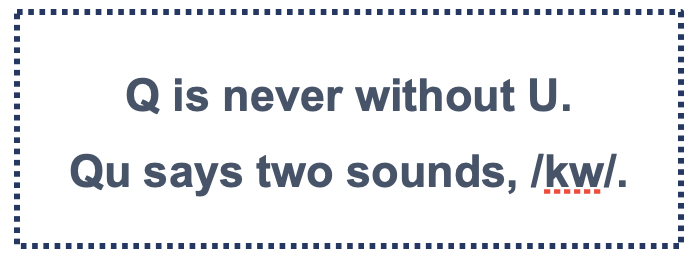
Of course, we all know that the letter ‘U’ can also appear on its own. For this next rule, make sure your student knows their short vowel sounds. Explain that when a vowel is closed off by a consonant, it is called a closed syllable, and the vowel will likely be short. Such as in this word:

However, when a vowel is not closed by a consonant, it will make its long sound. Now, most vowels have just one long sound, but the letter ‘u’ has two long sounds. Let’s take a look at our new rule to understand those two sounds a bit better.
![]()
What I love about our spelling rules is that their names help us understand exactly what they’re all about. I’ll show you what I mean. When the letter ‘u’ is open, it can make two sounds. The first sound is /oo/ as in the word ‘Emu.’ The second sound says /ū/ as in the word ‘Menu.’
I’m sure you’ve been wondering if there is a fun picture to go with our Emu on the Menu rule. There is! I was saving it for last!
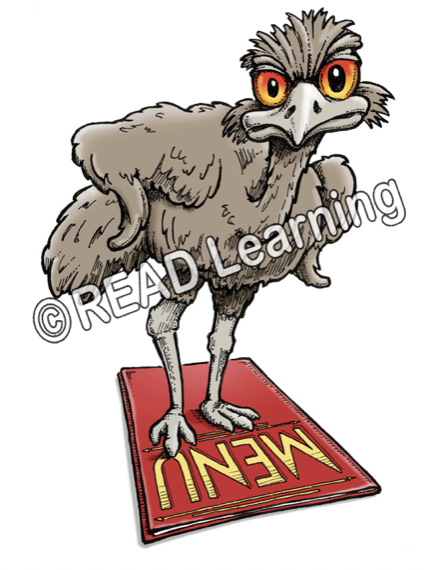
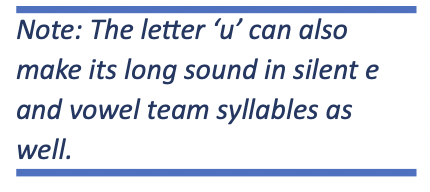
This allows you to focus on what matters most: learning and applying the rule. I highly suggest the Silver Moon Spelling Rules cards complete with illustrations for this rule. Both student and instructor sets of cards can be found here.

You can encourage your student to mark their vowels long or short. With ‘Qu,’ I often encourage my students to underline or box the two letters together, as to reinforce that ‘u’ is acting as a consonant, rather than a vowel. Check out our instructional video to get more tips and tricks for teaching syllable division techniques here!
You may find that students have learned to memorize a lot of words. This is especially common when working with older students. Therefore, it’s difficult to know for sure if your student has really learned the spelling rule to the point of generalization (note that this is the ‘good kind’ of generalization). Using a mix of real words and nonsense words helps you better understand what your student knows and eliminates the memorization variable.
Creating sentence frames are another good way to fade supports while practicing a spelling rule. You can find sentence frames for each rule in our FREE resources below.
Now that we’ve come to the end of our exploration of ‘U,’ I’d like to share some practice resources with you. When working with these concepts, practice will build automaticity. Our free reproducibles can help jumpstart your teaching practice.
Queen Quail and Emu on the Menu Reproducibles Here
Happy Teaching!
Written by:
Kate Wagner, BSE
Reading Interventionist, Remote Learning Coach